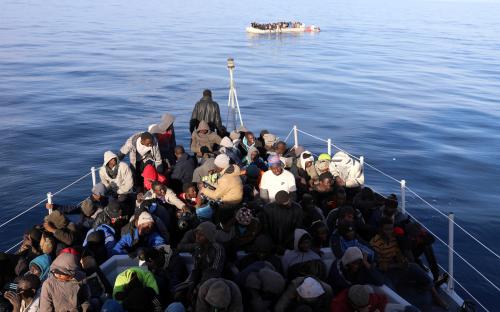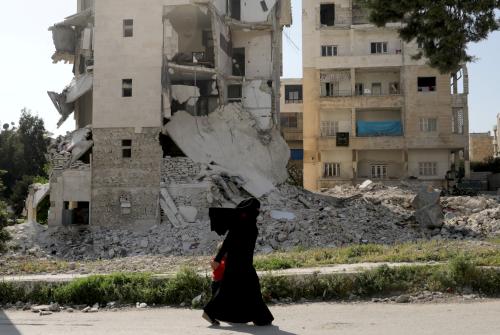In February 2020, the Libya-Italy Memorandum of Understanding on Migration (LIMUM) was extended for another three years. LIMUM provides Italian support to Libyan maritime authorities to stop vessels and return asylum-seekers to detention camps in Libya—a flagrant violation of European Union and international norms and legislation. The support has been about $100 million in training, ships, and equipment from Italy and the EU’s Trust Fund for Africa—the latter ostensibly established for development in migrants’ home countries. Though the migration route to Italy did shut down, some 40,000 people, including thousands of children, have been brought back to Libya to face horrific ordeals. Furthermore, while EU navies and private trawlers hired by Malta act as spotters for the Libyan coast guard, the last two NGO rescue ships were impounded by Italy in May 2020. In 2017, there had been 10.
Amnesty International says the mostly sub-Saharan African migrants and asylum-seekers held in detention centers face torture, rape, beatings, and appalling sanitary conditions. Human Rights Watch (HRW), Medecins Sans Frontieres, and others concur. Sale of migrants for their labor or to militias to extract payments from their families and friends in exchange for release or visiting less violence on them continues. It is estimated that some 1,500 are held in official detention centers run by the U.N.-recognized Tripoli Government of National Accord (GNA) and thousands more in centers controlled by militias. This number appears to be a decline from previous years but reliable numbers are hard to come by. The Council of Europe’s Commissioner for Human Rights, Bosnia’s Dunja Mijatovic, states “I am gravely concerned about certain types of assistance provided … in particular to the Libyan Coast Guard which have resulted in increased interceptions of migrants and asylum seekers … and their subsequent return to Libya, where they are subjected to serious human rights violations”.
Italy’s foreign minister has said that Rome asked Libya to make changes to the agreement, giving humanitarian groups some undefined responsibility for migrants caught by the Coast Guard—a statement viewed by HRW as “tweaking” an essentially broken and flawed arrangement.
This arrangement and attendant abuses have a history. Libya has long been both a destination and a transit point for migration to Europe. Estimating that there were some 2.5 million irregular migrants in Libya in 2011, the International Organization for Migration (IOM) underlined the abuses against migrants, including arbitrary, unfair, and indefinite detention, torture, extortion of bribes with violence, and threat of deportation. Among other agreements was a $5-billion, 20-year agreement with Italy to compensate for Libya’s colonization while safeguarding Italy from illegal migration.
The civil war in 2011 upended any arrangements and most migrants left. However, an unguarded coast of nearly 1,000 kilometers with Europe beckoning activated human smugglers while desperation once again pushed migrants onward. With no state authority, the current tragic situation took hold, with greed a principal driver but racism also playing a role, especially when it comes to the ransoming of human beings in detention centers and their sale for labor.
Yet Libya continues to act as a magnet for large numbers of migrants who come to work there or go on to Europe. Untold numbers of households from Chad to Egypt to Sudan depend on remittances from Libya. IOM estimates that in February 2020 there were at least 654,000 migrants in Libya. The top 5 nationalities were Nigerien (21 percent), Chadian (16 percent), Egyptian (15 percent), Sudanese (12 percent), and Nigerian (8 percent). Men constituted 89 percent of migrants, women 11 percent, and 7 percent were children of which 24 percent were unaccompanied. Of the migrants, 83 percent were employed and it cost them an average of $1,000 to reach Libya. They sent home $160 a month on average with monthly accommodation costs of around $50.
Clearly, Libya has a significant “pull” effect on migrants and asylum-seekers. However, all now face much higher risks—escalating violence, the COVID-19 pandemic, a potential food crisis, and further risks of trafficking for asylum-seekers as the economy worsens and repatriation and resettlement prospects close.
On May 13, 2020, seven U.N. agencies (OCHA, UNICEF, IOM, UNHCR, WFP, WHO, UNFPA) issued a joint statement that, due to conflict and COVID-19, the health and safety of Libya’s entire population was at risk. The escalation in fighting over the past year as warlord General Haftar moved to take Tripoli and oust the Government of National Accord (GNA) has led to thousands of casualties and a further 200,000 internally displaced persons, including migrants. Increasingly civilians are targeted as are health facilities, including a Tripoli hospital hit by Haftar’s forces hours after the joint U.N. statement that called for a pandemic ceasefire. As of May 13, 2020, there were only 64 COVID-19 cases in Libya but with deaths in three different regions underlining local/community transmissions, there are real fears of further expansion. Furthermore, food security is being compromised as most cities face shortages of basic food items amid rising prices and supply chain disruptions. Water supply facilities have also been targeted in the fighting, with dire implications for all residents.
These risks will impact migrants and refugees most immediately. According to the Mixed Migration Center, 75 percent of migrants and refugees became unemployed in March and April; many cannot afford rent and eat one meal a day. With all ports and airports closed on both sides of the Mediterranean and an acute, multipronged crisis in Libya, this is a humanitarian disaster of major proportions. UNHCR also notes that “desperation will drive more refugees to risk their lives and embark on dangerous journeys by sea.” To return asylum-seekers to Libya under these conditions is an abomination. Italy and the EU have the clout to improve conditions within Libya, including in the detention centers. They should do so. They will only be upholding their own laws and principles.






Commentary
Libya and its migrants confront new threats
May 20, 2020